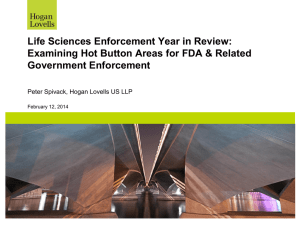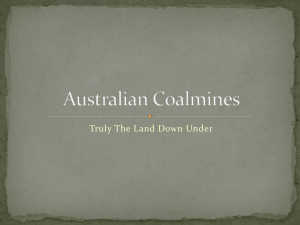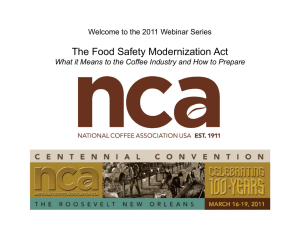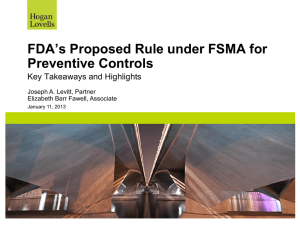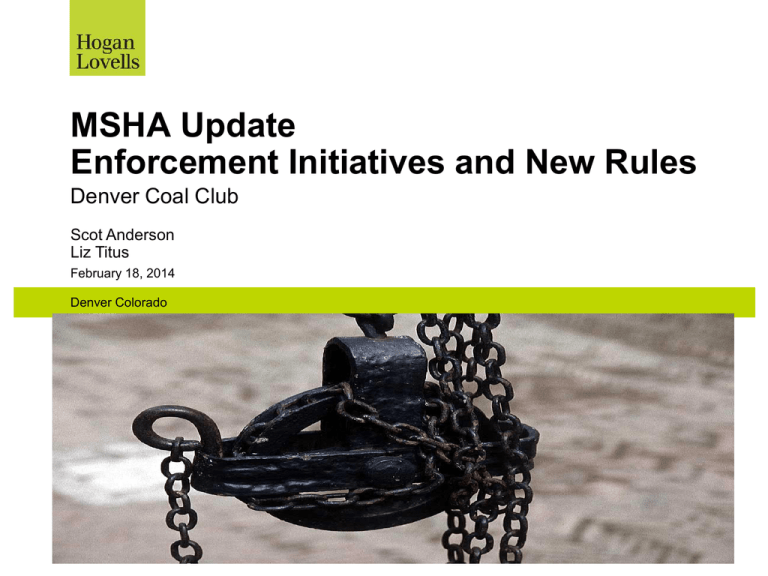
MSHA Update
Enforcement Initiatives and New Rules
Denver Coal Club
Scot Anderson
Liz Titus
February 18, 2014
Denver Colorado
MSHA Rulemaking
• Refuge Alternatives for Underground Coal Mines
– Request for Information (August 8, 2013)
• Lowering Miners’ Exposure to Respirable Coal Mine
Dust, Including Continuous Personal Dust Monitors
– Proposed Rule (October 19, 2010)
• Proximity Detection Rule in the works
www.hoganlovells.com
2
Underground Coal Mine Refuge
•
•
•
•
•
Request for Information
Published August 8, 2013
MINER Act (2006) amended
Mine Act to include requirement
that coal mines prepare an
Emergency Response Plan
(ERP).
Also includes NIOSH study of
refuge chambers.
MSHA publishes final rule in
2008 requiring refuge
alternatives for underground coal
mines.
Remanded by DC Circuit Court
of Appeals – no adequate basis
for holding hands-on training only
once a year rather than quarterly
www.hoganlovells.com
3
The Information Request
• Miner Training on
Refuge Alternatives
• In Place Shelters
• Escape Methodology
• Replacement of Brass
Fittings
• Testing and Approval
• Apparent Temperature
• Physiological and
Psychological Factors
www.hoganlovells.com
4
Respirable Dust
• Proposed Rule published
October 19, 2010
• The politics
– Bill proposed in House
Appropriations committee to
prevent funding for the
proposed rule
– George Miller (D-CA) – black
lung is on the rise again due
to ineffective regulation
•
NMA: isolated areas with
increase incidence of black
lung
– Abnormal White Centers and
the “addiction to cheating”
www.hoganlovells.com
5
“End Black Lung – Act Now” program (2009)
• Four Elements
–
–
–
–
www.hoganlovells.com
rulemaking
enhanced enforcement
collaborative outreach
education and training.
6
Proposed Rule (October 19, 2010)
•
Lower the existing concentration limits for respirable coal mine
dust from 2.0 milligrams of dust per cubic meter of air (mg/m³) to 1.0
mg/m³ over a 24-month phase-in period.
•
For intake air at underground mines and for Part 90 miners (coal
miners who have evidence of the development of pneumoconiosis)
from 1.0 mg/m³ to 0.5 mg/m³ six months after the effective date of the
final rule.
•
Establishes a weekly exposure limit when a continuous personal dust
monitor (CPDM) is used for sampling occupations on the MMU and for
Part 90 miners.
www.hoganlovells.com
7
Proposed Rule (October 19, 2010)
•
•
•
•
•
Require the use of the continuous
personal dust monitor (CPDM).
Over a 12- to 18-month period,
phase in the use of the CPDM that
provides a direct, real-time display of
respirable coal mine dust
concentrations.
Operators would use CPDMs to
continuously monitor underground
coal miners in occupations exposed
to the highest dust concentrations
and Part 90 miners.
CPDMs would be optional at surface
coal mines and for non-production
areas of underground coal mines
(such as outby areas).
The CPDM would electronically store
all respirable dust sampling data
collected during the shift; this data
would be sent electronically to
MSHA.
www.hoganlovells.com
8
Proposed Rule (October 19, 2010)
• Provide for the use of a single, full-shift sample
to determine compliance.
• Single, full-shift samples, collected by MSHA or the
mine operator, would be used to determine
noncompliance with respirable dust standards.
• Currently, multiple dust samples of different miners’
exposures are averaged.
www.hoganlovells.com
9
Proposed Rule (October 19, 2010)
• Require respirable dust sampling for the full shift a miner works,
rather than a maximum of 8 hours.
• Change the existing definition of “normal production shift” to
require sampling at a production rate that is more representative
of normal mining operations. Currently, the production level
required for a valid dust sample is 50 percent of the average
production, which results in respirable dust during sampling at
levels far lower than those miners are normally exposed to. The
proposal would require sampling when production is at least the
average production over the last 30 production shifts.
• Expand medical surveillance to add spirometry testing,
occupational history, and symptom assessment to the chest x-ray
examinations already required for underground coal miners and
extend medical surveillance to surface coal miners.
www.hoganlovells.com
10
Industry Concerns with the Proposed Rule
• A solution in search of a problem
– NIOSH Coal Workers Health Surveillance Program
– Not a representative selection
• CPDM Inaccuracies and Unreliability
• Ergonomics/Industrial Hygiene
www.hoganlovells.com
11
Calculating Exposure
• MSHA wants real time monitoring to reduce
exposure in excess of the standard
• MSHA example:
– Currently, multiple dust samples of different miners’
exposures are averaged, with some samples indicating
that miners are exposed to unhealthy dust levels far
above the current 2.0 mg/m3 standard. For example,
under the existing standard, five measurements of: 3.4,
2.7, 2.6, .7, and .5 would result in an average of 1.98,
which meets the 2.0 mg/m3 standard, although 3
individual measurements exceed the standard.
www.hoganlovells.com
12
Industry Concerns on Exposure Calculation
• Continuous Monitoring
creates 36 times more
samples; increases
likelihood of an outlier.
• Outliers drive up averages.
• Therefore, the mean value
must be very low to
compensate for the risk of
an unusually high sample.
• One comment on the rule
calculates that an operator
would need to keep the
mean value at the longwall
tailgate at 0.14 mg/m3 to
achieve 95% compliance.
www.hoganlovells.com
13
Enforcement Update
• Upper Big Branch Mine-South Corrective Action
Plan – Three New Public Policy Letters
• Pattern of Violations Rule
• MSHA v. Wolf Run Mining Co.
www.hoganlovells.com
14
Upper Big Branch Mine-South Corrective Action
Plan
Program Policy Letter P13-V-03 re Maintenance
of Cutting Bit on Continuous Miners and
Longwalls
• Makes clear that “cutting coal or rock with
continuous mining machines or longwall shearers
with damaged or missing cutting bits is a violation
of 30 C.F.R. § 75.1725(a).”
www.hoganlovells.com
15
Program Policy Letter P13-V-03
• Section 75.1725(a) provides
“Mobile and stationary
machinery and equipment
shall be maintained in safe
operating condition and
machinery or equipment in
unsafe condition shall be
removed from service
immediately.”
• “This policy is designed to
prevent the ignition of
methane caused by damaged,
worn, or missing cutting bits,
and thereby prevent the
accidents and injuries that can
result.”
www.hoganlovells.com
16
Upper Big Branch Mine-South Corrective Action
Plan
Program Policy Letter P13-V-11 re Program for
Regular Cleanup and Removal of Accumulations
of Coal and Float Coal Dust, Loose Coal, and Other
Combustibles
• MSHA’s cleanup program standard at 30 CFR §
75.400-2 requires mine operators to written clean up
program for regular cleanup and removal of
accumulations of coal and float coal dust, loose
coal, and other combustibles.
www.hoganlovells.com
17
Program Policy Letter P13-V-11
• Clean up program must include the following elements:
– The regular cleanup methods for the removal of
accumulations of coal and float coal dusts, loose coal, and
other combustibles in all active workings or on diesel-powered
and electrical equipment,
– The equipment and methods used for applying rock dust to
maintain 80% Total Incombustible Content (TIC) as required
by § 75.403 and the methods to continuously apply rock dust
to areas where coal dust is generated and float coal dust
accumulates; and
– The means to evaluate the effectiveness of their cleanup
program, such as review of preshift examination records, rock
dust usage, rock dust sampling results, and compliance
history. Mine operators should place emphasis on critical
areas such as longwall tailgates, belt transfer points, section
returns, and bleeder entries.
www.hoganlovells.com
18
Upper Big Branch Mine-South Corrective Action
Plan
Program Policy Letter P13-V-12 re Examination,
Evaluation, and Effectiveness of Bleeder Systems
• Provides guidance regarding description of bleeder system
in ventilation plan.
• Bleeder system are used to control the air passing through
a pillared area and to continuously dilute and move
methane-air mixtures and other gases, dusts, and fumes
from the worked-out area away from active workings and
into a return air course or to the surface of the mine.
• A bleeder system includes the area from which pillars are
wholly or partially recovered, bleeder entries, bleeder
connectors, and all associated ventilation control devices
that control the air movement through the area.
www.hoganlovells.com
19
Program Policy Letter P13-V-12
• District Managers would not suggest changes to the
relevant portions of existing approved ventilation
plans.
• MSHA anticipates that a ventilation plan will
include:
– description of the full extent of the worked-out area
intended to be ventilated by the bleeder system
– identification of bleeder entries (including rooms
surrounding the pillared area) intended to be examined
– Approved examination locations for methane, gases,
dusts and fumes
– Airflow direction at examination location and bleeder
entries should be demonstrated on a map or diagram
www.hoganlovells.com
20
Pattern of Violations Rule
• Eliminates initial screening and the potential
POV (PPOV) process.
• Eliminates the existing requirement that
MSHA can consider only final orders in its
POV review.
• Establishes two sets of general criteria and
procedures that MSHA will use to identify
mines with a pattern of S&S violations.
www.hoganlovells.com
21
Pattern of Violations Rule – Criteria 1
• MSHA generates a report to determine if a Pattern
of Violations exist within the preceding 12 months
– 50 citation/orders for S&S violations
– 8 or more S&S violations per 100 inspection hours, or the
degree of negligence of “high” or “reckless disregard” for
25% of the S&S violations
– At least 0.5 “elevated” citations/orders (i.e. issued under
sections 104(b); 104(d);104(g); or 107(a) of the Mine Act)
issued per 100 inspection hours
– An Injury Severity Measure (SM) for the mine that is
greater than the overall Industry SM for all mines in the
same mine type and classification (number of lost work
days per 200,000 employee hours)
www.hoganlovells.com
22
Pattern of Violations Rule – Criteria 2
• At least 100 S&S citations/orders issued in the
most recent 12 months.
• At least 40 elevated citations and orders [issued
under section 104(b); 104(d);104(g); or 107(a) of
the Mine Act] issued during the most recent 12
months.
www.hoganlovells.com
23
Pattern of Violations - Enforcement
• On Oct. 24, 2013, MSHA issued the first
three POV notices under its revised rule
• A forth POV notice was issued in November
of 2013.
• Down trend from PPOVs issued in 2012 (6),
2011(14) and 2010 (13)
www.hoganlovells.com
24
Recommendations
• Request conferences of S&S citations and those with “high”
degrees of negligence
• Conference may be only opportunity to reduce fees
• Consider contesting S&S citations and those with “high” degrees
of negligence – may not result in fee reduction
www.hoganlovells.com
25
Recommendations
Be mindful of Dodd-Frank Requirements
– the total number of violations of mandatory health or safety standards that
could contribute to a mine safety or health hazard and for which the operator
received a citation from MSHA,
– the total number of orders and citations issued under MSHA,
– The total number of flagrant violations and imminent danger orders issued
under MSHA,
– the total dollar value of proposed assessments from MSHA and the total
number of mining-related fatalities;
–
A list of mines, of which the reporting company or a subsidiary is the operator,
that receive written notice from MSHA of a pattern of violations, or a potential
for a pattern of violations, of mandatory health or safety standards that could
contribute to certain health and safety hazards; and
–
Any pending legal action before the Federal Mine Safety and Health Review
Commission involving a mine operated by the reporting company or a
subsidiary of the reporting company.
–
Pattern of Violation findings or imminent danger orders
www.hoganlovells.com
26
MSHA v. Wolf Run Mining Co. – Sago Mine
• On December 23, 2013, the FMSHRC reversed the ALJ’s
reduction of the negligence finding (from high to moderate)
for failing to immediately report the explosion at the Sago
Mine and vacated the unwarrantable failure designation
associated with the emergency control plan.
• Explosion occurred at 6:26 a.m.
– Lighting Strike on the surface
– At 6:32 a call describing airflow change
– At 6:36 another call stating that “we had a mine explosion or
something here.”
– Mine personnel went underground to investigate and assist in the
evacuation of miners.
– At 7:20 request to inform authorities
– No attempt to notify MSHA until 7:50
• 30 C.F.R. 50.10 requires immediate notification within 15
mins.
www.hoganlovells.com
27
MSHA v. Wolf Run Mining Co. – Sago Mine
• MSHA cited Wolf Run with violation of:
– Sec. 50.10 (High Negligence)
– Sec. 75.1502(a) (High Negligence, S&S and
Unwarrantable Failure)
• ALJ – Reduced negligence to Moderate, vacated
the Unwarrantable Failure, reduced penalties by
$2,500.
– Held that duty to notify did not occur until 7:23
– Stated that delay was motivated by desire to evacuate
survivors
– Noted that accident occurred on federal holiday.
www.hoganlovells.com
28
MSHA v. Wolf Run Mining Co. – Sago Mine
• Commission reversed the ALJ (2-1)
– Although an operator should be afforded a reasonable
opportunity to investigate, once it is determined that a
reportable accident has occurred, an operator must act
immediately to report the incident.
– Imposes a constructive knowledge standard generally used
for a finding of negligence (should have known vs. actual
knowledge)
– Cites intentional delay in contacting the mine rescue team, in
favor of attempting its own rescue.
“The operator's intention to assist underground personnel during
this emergency, while admirable, is exactly the type of conduct
that the Mine Act and the Secretary's regulations are intended to
address and avoid.”
www.hoganlovells.com
29
www.hoganlovells.com
Hogan Lovells has offices in:
Alicante
Amsterdam
Baltimore
Beijing
Brussels
Budapest*
Caracas
Colorado Springs
Denver
Dubai
Dusseldorf
Frankfurt
Hamburg
Hanoi
Ho Chi Minh City
Hong Kong
Houston
Jakarta*
Jeddah*
Johannesburg
London
Los Angeles
Luxembourg
Madrid
Miami
Milan
Moscow
Munich
New York
Northern Virginia
Paris
Philadelphia
Prague
Rio de Janeiro
Riyadh*
Rome
San Francisco
São Paulo
Shanghai
Silicon Valley
Singapore
Tokyo
Ulaanbaatar
Warsaw
Washington DC
Zagreb*
"Hogan Lovells" or the "firm" is an international legal practice that includes Hogan Lovells International LLP, Hogan Lovells US LLP and their affiliated businesses.
The word "partner" is used to describe a partner or member of Hogan Lovells International LLP, Hogan Lovells US LLP or any of their affiliated entities or any employee or consultant with equivalent standing. Certain individuals, who are
designated as partners, but who are not members of Hogan Lovells International LLP, do not hold qualifications equivalent to members.
For more information about Hogan Lovells, the partners and their qualifications, see www.hoganlovells.com.
Where case studies are included, results achieved do not guarantee similar outcomes for other clients. Attorney Advertising.
© Hogan Lovells 2014. All rights reserved.
*Associated offices

